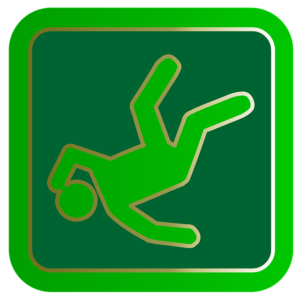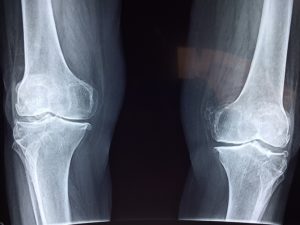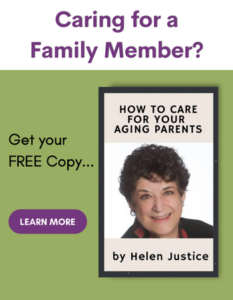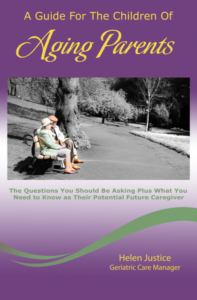Fall Prevention and Coping after a Fall
American writer and poet Gertrude Stein once said, “We are always the same age inside.” I couldn’t agree more. I still feel  young even though I am far beyond my twenties. When I dream, I am always much younger. When I look in the mirror, I am often surprised by the reflection of my older self.
young even though I am far beyond my twenties. When I dream, I am always much younger. When I look in the mirror, I am often surprised by the reflection of my older self.
I will, however, readily admit that I am no spring chicken. My body isn’t what it used to be and sometimes my age attacks when I least expect it. It is frustrating. I get myself into all kinds of messes, including an occasional injury.
Age related physical changes, mental conditions, health conditions, and even medications increase the risk of injury. Falling is the leading cause of injury among seniors ages 65 and older. In fact, each year one in three seniors will have a fall. As we age, a serious fall can be the difference between freedom of movement and wheelchair, or worse, the difference between living comfortably at home and moving to a care facility. One serious fall can be life changing.
Unfortunately, 2 million seniors will be treated in an emergency setting for fall-related injuries this year alone. For seniors, fractures are one of the most serious consequence of falls. Serious falls may cause hip fractures or even life-threatening head injuries. In 2013, the direct medical costs of older adult falls, adjusted for inflation, were $34 billion.
While the aging population continues to increase, both the number of falls and the costs to treat the associated injuries will also increase. Even when there’s no serious injury, a fall can still be scary enough that we choose to avoid certain activities because we are fearful of another fall. Falls can have an adverse psychological impact on the aging. For example, after having a fall some can lose confidence, become withdrawn and feel as if they have lost their independence entirely.
The fear of falling doesn’t need to control a life. Below we have compiled some useful information to help you or a loved one prevent falls and cope after a fall.
Make an Appointment with your Doctor if You Fall or have a “Close Call”
According to the Centers for Disease Control and Prevention, fewer than half of seniors who experience a fall will actually talk with their doctors about it. Many will rationalize and conclude that the fall “wasn’t serious enough.” It is important to remember that ALL FALLS ARE POTENTIALLY SERIOUS. You or your family member should see their health care provider if they have fallen, even if they are not hurt. Remember to record the details of the fall, including when, where and how.
It is also important to discuss instances when you almost fell. For example, you were caught by someone, were able to brace yourself just in time, or you became so dizzy that you rushed to a chair or bed before it was too late. These types of details may help you and your doctor identify fall-prevention strategies to protect you.
Review your Medication(s) and Eye Sight with Your Health Care Provider
If you have fallen, have been feeling dizzy, or your sense of balance has declined, consider reviewing the medications are you taking with your health care provider. Some medicines (or combinations of medicines) can have side effects such as dizziness or drowsiness. This can make falling more likely. The Mayo Clinic recommends that you:
Make a list of your prescription and over-the-counter medications and supplements, or bring them with you to the appointment. Your doctor can review your medications for side effects and interactions that may increase your risk of falling. To help with fall prevention, your doctor may consider weaning you off certain medications — such as sedatives and some types of antidepressants.
Poor vision can make getting around safely very difficult. Aging seniors should have their eyes checked annually and wear glasses or contact lenses with the proper prescription strength to ensure clear eye sight. The Mayo Clinic adds:
Certain eye and ear disorders may increase your risk of falls. Be prepared to discuss your health conditions and how comfortable you are when you walk — for example, do you feel any dizziness, joint pain, numbness or shortness of breath when you walk? Your doctor may evaluate your muscle strength, balance and walking style (gait) as well.
Eliminate Home and Clothing Hazards
Over one half of all falls happen in the home or yard. A safety check in the home (including exits), garage and yard can identify hazards that need to be removed, changed or upgraded. To make your residence safer, consider:
Moving, downsizing, or eliminating coffee tables, book shelves, electrical and phone cords, or plants from high-traffic walkways outside and inside.
Securing rugs and doormats with tape, nails or a slip-resistant backing (or remove the rugs entirely from the home).
Swapping out chairs and couches that are unsafe or difficult to stand up from.
Using nonslip mats in the shower or bathtub.
Repairing loose tile, stairs, sidewalks, floorboards and carpeting.
Storing tools, clothing, dishes, food and other necessities in areas that are easy to reach.
Avoiding wearing loose clothing. Regardless of how comfortable they might be, baggy clothing can make a fall more likely.
Consider changing your footwear (shoes, socks, and slippers). Properly fitting, sturdy footwear with nonskid soles can prevent falls.
This safety check should include a review of your clothing and foot apparel. There is a myriad of outer garments, underwear, leisure wear, footwear and other specialized clothing available for elderly people with Alzheimer’s, arthritis, mobility issues, foot problems, incontinence, scoliosis or obesity issues.
Medical Equipment and Assistive Technology
Medical equipment is a term often used to refer to a larger category of services called assistive technology. Assistive technology is a broad term and may mean different things to different people but for our purposes we will define it as devices or systems to help the elderly function safely at home. Assistive technology can include:
Hand rails for entrances and stairways
Lifts and ramps
Nonslip treads for the floor
Raised toilet seats with armrests
Grab bars and nonslip treads for the shower or tub
A sturdy plastic seat for the shower or tub
Elevated toilet seats
Wheelchairs and scooters
Oxygen equipment
If you or a loved one spends a substantial amount of time at home, and is at increased risk of falling, consider subscribing to a personal emergency response system. This service, which operates through your home phone line, provides a button or bracelet to wear at all times in your home. Carrying a cell phone in your pocket while you are at home can also make it easier to call someone if you need assistance.
Great care and consideration should be used for those who are at a fall risk and have been diagnosed with dementia. Although many of the items mentioned above can be very helpful, those with memory issues may forget to utilize them properly.
Physical Activity
The Mayo Clinic recommends that:
Physical activity can go a long way toward fall prevention. With your doctor’s OK, consider activities such as walking, water workouts or tai chi — a gentle exercise that involves slow and graceful dance-like movements. Such activities reduce the risk of falls by improving strength, balance, coordination and flexibility. Lack of exercise can lead to weak legs and this increases the chances of falling. Exercise programs such as Tai Chi can increase strength and improve balance, making falls much less likely.
Practice Getting up from the Floor
Can you get up from the floor on your own right now? The answer to that question may depend on your age, health, past injuries and what is available to grab to help you up. Knowing whether or not you can get up from the floor by yourself is important. You might consider testing your ability. If it is difficult, can practicing with a stand by assistant help you develop this skill? Don’t wait until you fall down to work out how to get up. If you practice getting up and down from the floor on a regular basis, you might be surprised by the results.
If You Fall
A sudden fall can be startling and upsetting. Knowing what to do if a fall occurs can help you or a loved one be less afraid of falling. Whether you are at home or somewhere else, the steps below, provided by NIH Senior Health, can help you know how to get up from a fall.
Remain still on the floor or ground for a few moments. This will help you get over the shock of falling.
Decide if you’re hurt before getting up. Getting up too quickly or in the wrong way could make an injury worse.
If you think you can get up safely without help, roll over onto your side.
Rest again while your body and blood pressure adjust. Slowly get up on your hands and knees, and crawl to a sturdy chair.
Put your hands on the chair seat and slide one foot forward so that it is flat on the floor. Keep the other leg bent so the knee is on the floor.
From this kneeling position, slowly rise and turn your body to sit in the chair.
If you’re hurt or can’t get up on your own, ask someone for help or call 911. If you’re alone, try to get into a comfortable position and wait for help to arrive.
When someone has a serious fall and, for example, breaks their hips, they can feel that the situation is the beginning of the end. A fear of become increasingly frail and incapacitated can set in. Care.com has offered some helpful suggestions to help the elderly cope with depression after a fall. Here are some things you can do:
Empathize with your parent’s feelings.
Don’t minimize the situation, but remind your parent that it is temporary and that he or she will become more fully mobile little by little.
If your parent continues to feel depressed, tell the doctor and make sure the depression gets treated and starts to improve.
Any exercise that your parent is able to do will help improve his or her mood.
Conclusion – Address the Fear of Falling, Eliminate Risk, and Find Ways to Cope after a Fall
Each year one in three seniors will have a fall. Unfortunately, there is a common pattern when it comes to falls among the aging: risks increase, fear of falling ensues, the fall and subsequent injury, followed by hospitalization, rehabilitation, decreased independence and mobility, and often relocation to a nursing or residential care facility. One serious fall can be life changing.
Simple home modifications, the use of assistive devices, wearing sensible footwear, and removing hazards can reduce the risk of falling and the injuries that come with it.
If you’re worried about falling or having another fall, talk with your doctor or another health care provider. Getting rid of your fear of falling can help you to stay active, maintain your physical health, and prevent future falls.
Known by many as “The Elder Care Navigator”, Helen Justice is a Certified Geriatric Care Manager trained to assist elders and their families with the process of aging with dignity and grace. Her knowledge and experience insures elders obtain quality care and transitional preparation for their future. More important than the financial aspect of aging is the social and emotional component that elder care places on the family. Go to www.advancedwellnessgcm.com for information on no fee seminar.
 member or friend. The National Association for Home Care & Hospice reports that over 12 million individuals currently receive care from more than 33,000 providers (for causes including acute illness, long-term health conditions, permanent disability, or terminal illness).
member or friend. The National Association for Home Care & Hospice reports that over 12 million individuals currently receive care from more than 33,000 providers (for causes including acute illness, long-term health conditions, permanent disability, or terminal illness).






Stay Up To Date With AWGCM